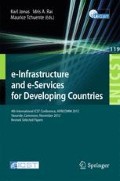Abstract
Internet Protocol version 4 (IPv4) addresses have been reported to be nearing exhaustion and the next generation Internet Protocol version 6 (IPv6) is gradually being deployed in the Internet. IPv6 provides a much larger address space, better address design and greater security, among other benefits. IPv6 deployment requires thorough and careful preparation to minimize network disruption and ensure that the benefits of IPv6 are obtained. The migration from IPv4 to IPv6 cannot be achieved in a short period thus the two protocols will co-exist for some time. Unfortunately, these two protocols are incompatible; hence for them to co-exist, various IPv4-to-IPv6 transition mechanisms have been developed. In this paper, we analyse the different site-to-site tunneling mechanisms through a theoretical and experimental evaluation to study their appropriateness in IPv6 deployment for enterprise networks in developing countries. Using five performance metrics, namely: end-to-end delay, jitter, throughput, packet loss and CPU utilization, our experimental results indicate that Configured Tunneling performs better than the other tunneling mechanisms. This study is of importance to those enterprise networks which want to implement IPv6 and are concerned about which transition mechanisms to embrace depending on the performance requirements.
Access this chapter
Tax calculation will be finalised at checkout
Purchases are for personal use only
Preview
Unable to display preview. Download preview PDF.
References
Next Generation Internet: IPv4 Address Exhaustion, Mitigation Strategies and Implications for the U.S. An IEEE-USA White Paper (2009)
Sailan, M.K., Hassan, R., Patel, A.: A comparative review of IPv4 and IPv6 for research test-bed. In: Proceedings of the International Conference on Electrical Engineering and Informatics, pp. 427–433. IEEE Computer Society, Washington (2009)
Govil, J., Kaur, N., Kaur, H.: An examination of IPv4 and IPv6 Networks: Constraints and Various Transition Mechanisms. In: Proceedings of the 2008IEEE Southeastcon, pp. 178–185. IEEE Computer Society, Washington (2008)
Waddington, D., Chang, F.: Realising the transition to IPv6. IEEE Computer Magazine 40(2), 138–147 (2002)
Internet Systems Consortium. Number of Internet hosts (retrieved July 18, 2012), https://www.isc.org/solutions/survey/history
Deering, S., Hinden, R.: Internet Protocol, Version 6 (IPv6) Specification: RFC 2460 (December 1998)
Cisco Systems: Next Generation Transition (ngtrans) working group (retrieved July 18, 2012), http://www.ietf.org/wg/concluded/ngtrans.html
Odinma, A.C., Butakov, S., Grakhov, E., Bollou, F.: Planning, designing and implementing an enterprise network in a developing nation. Int. J. Enterprise Network Management 2(3) (2008)
Hagen, S.: IPv6 Essentials. O’Reilly, ISBN: 0-596-00125-8
Vlaovic, B., Brezocnik, Z.: Packet Based Telephony. In: EUROCON 2001, Trends in Communications, vol. 1 (2001)
Dainotti, A., Botta, A., Pescapè, A.: A tool for the generation of realistic network workload for emerging networking scenarios. Computer Networks 56(15), 3531–3547 (2012)
Author information
Authors and Affiliations
Editor information
Editors and Affiliations
Rights and permissions
Copyright information
© 2013 ICST Institute for Computer Science, Social Informatics and Telecommunications Engineering
About this paper
Cite this paper
Sansa-Otim, J.S., Mile, A. (2013). IPv4 to IPv6 Transition Strategies for Enterprise Networks in Developing Countries. In: Jonas, K., Rai, I.A., Tchuente, M. (eds) e-Infrastructure and e-Services for Developing Countries. AFRICOMM 2012. Lecture Notes of the Institute for Computer Sciences, Social Informatics and Telecommunications Engineering, vol 119. Springer, Berlin, Heidelberg. https://doi.org/10.1007/978-3-642-41178-6_10
Download citation
DOI: https://doi.org/10.1007/978-3-642-41178-6_10
Publisher Name: Springer, Berlin, Heidelberg
Print ISBN: 978-3-642-41177-9
Online ISBN: 978-3-642-41178-6
eBook Packages: Computer ScienceComputer Science (R0)

